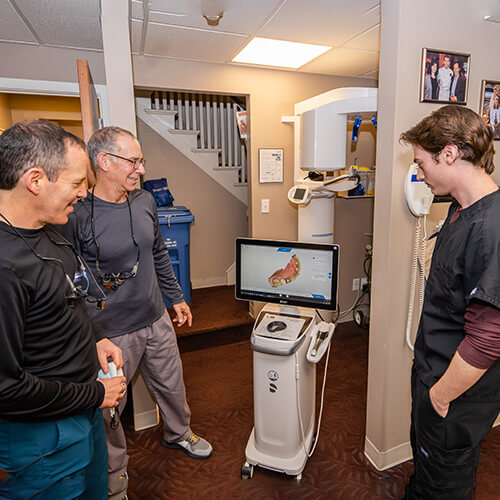Smile Design in Pleasantville, NJ
Get your dream smile at Goodman & Rosenberg.
Transform Your Smile with a Smile Design

Do you look in the mirror or at pictures and wish you had a different smile? You’re beautiful inside and out, but if you don’t feel like yourself because of a smile flaw, then let’s fix it with a custom-made smile design!
You deserve to feel your best, and a smile design in Pleasantville, NJ with Goodman & Rosenberg makes your dream smile a reality. We combine different restorative and cosmetic dentistry procedures to create the teeth you desire.
Smile design options include:
Your dream smile is closer than you think.
Benefits of a Smile Design
A custom smile design helps patients feel good in their own skin.
A whiter, straighter, fuller smile instantly improves a person’s appearance.
A smile design doesn’t have to be cosmetic; we can restore your natural teeth as well.
How a Smile Design Works

After an initial consultation at Goodman & Rosenberg in Pleasantville, NJ, we’ll create a custom plan to bring you the smile of your dreams. It’s typically a combination of treatments involving restorative dentistry, cosmetic dentistry, or both.
Smile design can be done to improve your appearance or restore your teeth after damage. Each person is unique, so we consider your entire facial appearance, including but not limited to your face shape, lips, and gumline. The result is a natural, beautiful smile.
-
Step 1
First, we meet and set your goals and evaluate your existing smile. This includes examining oral health, jaw alignment, and facial structure. With models or dental imaging, we’ll show you the possible outcome before we begin. Creating a trial smile lets you see what you’ll look like before committing to treatment.
-
Step 2
We create a plan. We can do as little or as much as you want to give you a smile you love and feel good about. By fixing your smile, we’ll correct the look of your teeth and create an overall improvement in appearance.
-
Step 3
Treatment starts, and we create your perfect smile.
Our cosmetic and restorative dentists in Pleasantville, NJ are here to help you become the person you’ve always wanted to be.
FAQ about Smile Design in Pleasantville, NJ
-
How much does it cost to fix your smile?
The cost of fixing your smile depends on your goals and the procedure. Each case is unique.
Please contact Goodman & Rosenberg in Pleasantville, NJ for a smile design consultation.
-
What is a smile design?
A smile design is a custom plan to bring you the smile of your dreams. It’s typically a combination of treatments involving restorative dentistry, cosmetic dentistry, or both.
Options include orthodontics (metal braces or clear aligners), whitening, fillings, bonding, veneers, dental implants, and crowns.
A smile design enhances your appearance while maintaining a natural look for teeth. It has the power to alter the alignment and spacing of teeth, their size, shape, and color. The result is a natural-looking, beautiful smile that suits your face.
We’ll define your goals – are you looking to brighten your smile, straighten your teeth, restore missing teeth, or completely reinvent yourself? Then we’ll create and execute the plan.
-
How is smile correction done?
Smile correction is done using a specific treatment or several treatments to fix and create your perfect smile. This can involve a mix of restorative or cosmetic dentistry options.
-
How do celebrities get perfect teeth?
Many celebrities get perfect teeth with a smile design/smile makeover. While there are many celebrities with natural teeth who only need whitening, others have porcelain veneers, which are custom-made porcelain shells adhered to teeth for a flawless appearance. Veneers can completely change the look of a person’s teeth.
The best part about a celebrity smile is that it looks natural, and with our custom smile makeover/smile design, we can do the same for you. Contact us for your smile design consultation today.
-
Are veneers safe?
Yes, veneers are safe. They’ve been used for years, and we’re experienced in creating perfect smiles with the application of custom-made veneers.
Schedule Your Appointment
Tuesday 9:00am - 7:00pm
Wednesday 9:00am - 5:00pm
Thursday 8:30am - 5:00pm
Friday 8:30am - 2:00pm
Call Us at 609-641-1462

